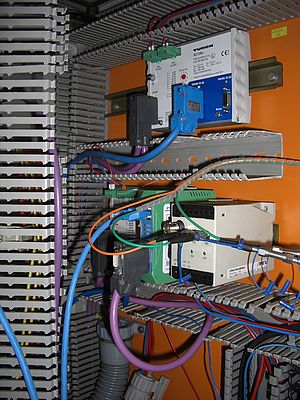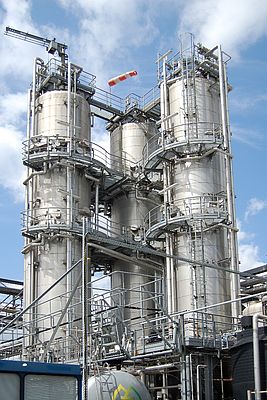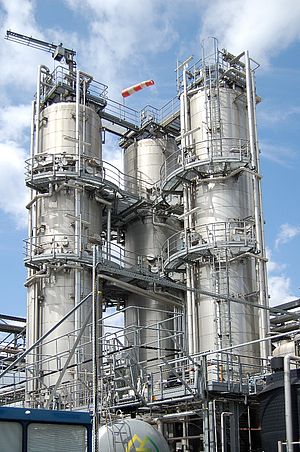Two thirds of all users consider permanent monitoring of PROFIBUS networks necessary, though a few have actually implemented it today. At Evonik Goldschmidt, the web-based xEPI 2 with integrated diagnosis has passed its first real application test with flying colors.
Right in the center of Essen/Germany, Evonik Industries operates the largest industrial site of the city at its chemical site on Goldschmidtstraße. Some 1,400 people work at the 27 hectares site. It has a long tradition and has been a major industrial employer in the city since 1889. Nowadays, the plant manufactures raw materials and auxiliaries, additives and active principles, which primarily are used for producing consumer goods and in the chemical industry.
Within the scope of a field test, Evonik Goldschmidt has thoroughly tested the Trebing & Himstedt xEPI 2 and its functions as a diagnostic unit and configuration interface. The chemical business implemented the versatile gateway, in three installations in different PROFIBUS systems and with various PROFIBUS masters: an Emerson DeltaV control system, a Siemens Simatic S7, and even a 12-15 year old A250 Schneider Electric control system connected to digital communication via third-party PROFIBUS card.
It did not take long until the diagnosis tool provided the first valuable results and insights. “The PROFIBUS isn’t something that breaks down constantly. When it’s up and running, it keeps running,“ says Dirk Deckers, who works in the Electrical Engineering and Process Control Service Department in Evonik Goldschmidt’s Consumer Specialties business unit in Essen. “Although the bus seemed to be functioning perfectly, for the first time ever we realized all the things going on on the bus, and we immediately identified scores of irregularities.“ For the most part, the malfunctions could be removed immediately by small re-configurations of channel diagnoses. The site service, besides project handling also responsible for supervision of all installations on the site, will work through the remaining diagnosis telegrams at the next opportunity, to ease the load on the bus.
With the test application progressing, Deckers’ absolutely favorite feature quickly emerged: the automatic email alert function. After starting his computer, he immediately knows if there are any problems or not. As the engineer puts it, “The best thing about it is that I only need to start searching and checking at all if there is an email in my inbox. All I want to know is if there has been a problem or change at the bus. That’s all I really care about.“ And he adds, “Besides that, the integrated diagnosis functions narrows the troubleshooting down extremely.“ That is because the tool informs the user on whether there are problems with the bus or if it’s a case of a failed channel. So users will not get stuck in bus failures if it is all about one single channel. Only card and device then remain as sources of error.
Evonik equipment is subjected to constant optimization processes; there are always some changes or extensions. The bus runs stable but hardly unaffected. It is like open-heart surgery – including the high risk of error. Incorrectly attached bus connectors, for example, can turn the DP line into an antenna and cause (partial) downtime. Such failures are hard to identify. Mostly, things still keep running smoothly, but if not, Deckers and his colleagues are faced with a real challenge. Valuable production hours could be spent troubleshooting. But with permanent monitoring of the PROFIBUS network, whoever is in charge can track what has been done when and where – which means that failures can be located much more quickly.
In a worst-case scenario, firms expect stand-by engineers to react quickly, including night-time cases. But if it takes an hour to arrive on the spot, “quick” becomes somewhat relative. The solution: the colleague on call starts up his notebook at home, logs on to the terminal server via secure “demilitarized zone” (DMZ), starts the Web interface and can diagnose the production network. And in no time, he can inform the electrician where to look for the failure. “The xEPI 2 has reduced reaction times extremely. A few hours of batch-plant downtime easily amount to a loss of EUR 50,000 or more, depending on the product,“ underlines Deckers. “So if there is a device that I can purchase at a fraction of this sum, I surely don’t have to think twice.“
The initial basic function of the Ethernet-PROFIBUS-Interface, however, was quite different: as the name may suggest, the original purpose of first-generation gateways was to connect production network and fieldbus level. This enables central and manufacturer-independent configuration of field devices. “There are several manufacturers who provide pure PROFIBUS access,“ explains Deckers. “That’s nice to have. But what is really clever about the xEPI 2 after all is its permanent bus monitoring on top of that. The device is always in action; it provides me with information and keeps me up-to-date.“ Users simply have to switch online between the different functionalities supported by the gateway.
Monitoring and configuration
in one single gateway
- by Trebing & Himstedt GmbH & Co. KG
- April 2, 2012
- 371 views



















